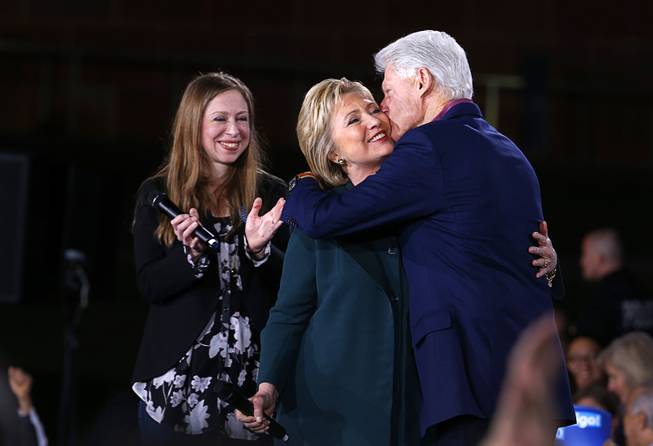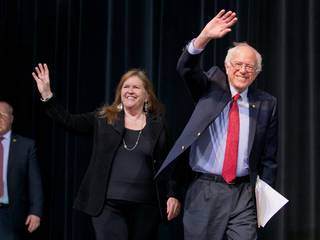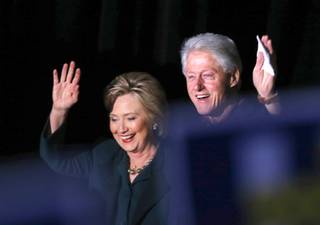
Democratic presidential candidate Hillary Clinton gets a kiss from her husband and former President Bill Clinton as daughter Chelsea looks on during a rally at the Clark County Government Center Friday, Feb. 19, 2016.
Saturday, Feb. 20, 2016 | 2 a.m.
More Coverage
- In Henderson, Sanders urges voters to ‘make history’
- Blog: Clinton, Sanders make pitch to sway voters at Las Vegas town hall
- Caucusing 101: How it works, and where Clinton and Sanders stand on key issues
- Trump staying away from Nevada ahead of GOP caucuses
- Nevada poll: Clinton, Sanders tied; Trump way ahead
- The Sun's political coverage
Today, Nevada is a question mark.
It had long been assumed by pundits — and shown by polls — that former Secretary of State Hillary Clinton would easily coast to a Nevada victory in today’s Democratic caucuses.
That narrative started to shift after her opponent, Vermont Sen. Bernie Sanders, lost to Clinton in Iowa by a much narrower margin than expected and beat her in New Hampshire by a larger than expected margin.
Still, there is a reason that Clinton set up a ground game so early in the state. They didn’t know who they would be up against, but they were ready for a fight. Her staff hit the ground running in April, six months before the Sanders campaign. When Clinton kicked off campaign trips, Nevada was her third stop after visits to Iowa and New Hampshire.
Over the past several months, both campaigns have raised hundreds of thousands of dollars, amassing thousands of volunteers who have put in countless hours phone banking, canvassing and registering people to vote.
Now, with Iowa and New Hampshire behind them, it’s Nevada’s turn to take center stage.
This week, the candidates traveled up and down the state, making stops in and around the Las Vegas Valley, Reno and Elko.
Under the fluorescent lights of employee dining halls and linen rooms on the Strip, Clinton made last-minute pleas for votes over the weekend and in the past couple of days, posing for hundreds of photos and reminding people what time they needed to show up on Saturday to caucus for her. Sanders followed suit Friday night, visiting at least one hotel, greeting workers at the employee dining room at Caesars Palace.
The visits with casino workers — which gets the candidates in front of some of the members of the state’s largest and most politically active union, the Culinary Union, which is staying neutral in the caucuses but encouraging its members to vote — are just one example of how the candidates have paralleled each other in their efforts to win Nevada this week.
Last weekend, Sanders met with a group of solar workers who were laid off in the wake of the Nevada Public Utilities Commission's December decision to increase bills for solar customers. Friday, Clinton visited the home of a woman who was halfway through the process of installing solar panels on her roof when the commission made its decision.
In a tense moment on Sunday, Clinton and Sanders sat in opposite pews at the same service at one of the most well-known black churches in the valley and both preached a version of their standard stump speeches to congregation members.
The candidates have taken shots at each other, both obliquely and directly, as the battle for the Democratic nomination has heated up. But on Friday night, in their final pitches to voters, the messages from both candidates focused on the positive.
Clinton, speaking to a crowd of about 1,500 at the Clark County Government Center amphitheater, rallied her supporters around her vision for the future, beginning nearly every thought with the phrase “imagine a tomorrow.”
“Imagine a tomorrow where the barriers of racism, sexism, homophobia, all of the bigotry that still unfortunately exists is finally diminished so that people can live up to their own dreams. Where they can be judged on their own merits,” Clinton told the crowd, flanked by her husband, former President Bill Clinton, and their daughter, Chelsea.
Sanders, meanwhile, speaking to an energetic crowd of more than 2,000 supporters at the Henderson Pavilion, focused on the historical importance of the caucus, saying that Nevadans have a chance to make history and start a political revolution.
“We are going to create an economy that works for all of us, not just the 1 percent,” Sanders said.
For as much effort as the candidates have put in on the campaign trail over the last week, the battle for Nevada has been steeped in the details — in voter registration, in phone banking and in door knocking. Today’s vote will show to what extent each campaign was able to do those things to get their supporters out to the caucuses.
By all measures, Clinton’s campaign has followed the conventional political playbook to a T. She hired a solid team with extensive connections here in Nevada. She started reaching out to the Latino community early on. She landed the endorsements of most of the key Democratic figures in the state (Senate Minority Leader Harry Reid being one notable exception, since he has declined to endorse ahead of the caucuses).
The Sanders campaign has long acknowledged it is running a different kind of campaign — grassroots, they stress. The campaign actually emphasizes that they don’t have Clinton’s long list of endorsements, saying their campaign reflects the support of everyday people and a broad base of support.
“We’re not going to come out with lists that are huge like our opponent, like the Clinton campaign,” state director Joan Kato said in January. “We’re going to come out with names of the average person.”
In a couple of months, Sanders became a serious contender for the nomination holding his own against Clinton. In that time span, the campaign hired 100 staff members and opened up a dozen field offices across the state. The Sanders campaign’s advertisements went up on the airwaves first in Nevada, in December.
The question now is whether Clinton’s solid organizational support or Sanders’ more unconventional but extensive efforts in the state will pay off.
For their part, Sanders' supporters are preparing for a close race like Iowa. In a video released late Thursday night, Sanders' supporters asked volunteers to film their caucus proceedings, upload them to YouTube, and provide the video links to be aggregated on one YouTube account.
The state Democratic Party is bracing itself for criticism from both sides over the results of the caucuses. The party sent out a letter to the campaigns Friday stressing the need to provide correct information about caucus rules to their supporters. (The Sanders campaign released a video this week instructing voters how to caucus that contained some inaccurate information about candidate viability.)
Part of what happens today also depends on turnout. Polling has shown that Sanders tends to do well with millennial voters and Clinton tends to do well with women, so who turns out could make a significant difference.
At their Friday night rallies, both candidates were buoyed up by the chants and cheers of their thousands of supporters. The questions remaining are how many of those supporters will turn out to caucus and how many undecided voters can each campaign sway inside the caucus rooms.
Earlier Friday evening, Clinton toured through an employee dining room at Planet Hollywood. She was approached by one of the casino’s dealers, 48-year-old Chris LaCascia, whose muscles bulged out from behind his tight, red and black sleeveless shirt.
She laughed and took a picture with him showing off his muscles.
Afterward, he told reporters that it was great meeting her.
Would he caucus for her tomorrow, a reporter asked?
“Ehhhh,” he started. “I’m still on the fence.”



Join the Discussion:
Check this out for a full explanation of our conversion to the LiveFyre commenting system and instructions on how to sign up for an account.
Full comments policy